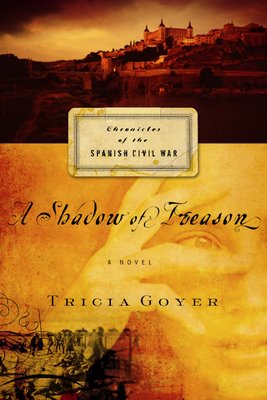 Please welcome Tricia Goyer as she discusses researching for historical novels. And though we've all learned something, how many of our writers of historicals have appreciated her visits this month on Manuscript Mondays? Thanks, Tricia!
Please welcome Tricia Goyer as she discusses researching for historical novels. And though we've all learned something, how many of our writers of historicals have appreciated her visits this month on Manuscript Mondays? Thanks, Tricia!I don't know about you, but I spend twice as much time researching for my historical novels than even writing them.
The first thing I do is work through Randy's Snowflake to get an idea of just what I'll need to research. For example, on A Shadow of Treason is about The Spanish Civil War. Before that, for Arms of Deliverance, I wrote about B-17 crews, female war correspondents, the Belgium underground, and Lebensborn homes.
After I Snowflake, I promptly go on-line and check out books available in my library system and books I need to purchase. I'll also do Internet searches on the subject, but I usually find much of my information in books.
Next, I created an Excel file for each of my characters and/or major subjects. They include the following headings:
Date, Action (what's taking place), Dialogue, Others (meaning interaction with others), Physical Description, Setting, Additional Research, Worse Possible Scenerio, Outcome.
I then read through my books and mark them with small post-its. I also highlight books I own. After that I enter these notes into my Excel databases. I've discovered the more I "handle" the information, the more I'm able to wrap my mind around it.
At this point, I use Writing the Breakout Novel by Donald Maass workbook to flesh out my characters and fine tune my plot.
In the previous two steps I'll even begin writing short scenes or bits of dialogue as they come to me so I don't lose them.
When that is done, I have a basic idea of the flow of my novel and even a very thin skeleton of scenes.
Finally, I start a file which is actually going to be my WIP. I alternate between writing the first chapters and moving the Excel notes over into the document. For example, if I know one of my first scenes opens with a B-17 getting attacked by German pursuits over occupied France, I'll create a section with B-17 descriptions, typical crew responses, etc.
Then, if I know the next section will introduce my female correspondent, I'll put my research notes for her next.
I keep doing this through the document in the basic outline of where I'll need the information.
(And I'm still not writing the book yet!)
It's at this point I also start looking for WWII vets or other historians to help me. For example, for B-17 crews, I figured out the exact Bomber group and squadron I needed for my WIP and then I searched for men in that squadron. Unbelievably most have websites and organizations, so I email the heads of that organization. The veterans are usually quite flattered that I've chosen them specifically, and many offer to answer questions.
 I wait this far into my research before involving them, because I want to make sure to ask intelligent questions. I don't need to ask about crew duties, because I've found books to tell me that. Instead, I ask about specific missions, their emotional reactions, their personal experiences in London during liberty, etc. And they love helping!
I wait this far into my research before involving them, because I want to make sure to ask intelligent questions. I don't need to ask about crew duties, because I've found books to tell me that. Instead, I ask about specific missions, their emotional reactions, their personal experiences in London during liberty, etc. And they love helping!Finally, I write the story.
I know that for some of you, this may seem like a crazy amount of research, but I adore it. Also, when I get to the point of writing, I write fast--like 80% of the manuscript in the month and 1/2 before it's due . . . which gives you a hint of what I'm doing this month!
Tricia Goyer
Check out all of Tricia's historical fiction
For more than a decade, author Tricia Goyer has drawn from her experiences as a teen mother and leader of today’s generation, to be a voice of hope and possibility for all teen girls, pregnant teens, mothers and wives. To learn more, visit: www.triciagoyer.com
